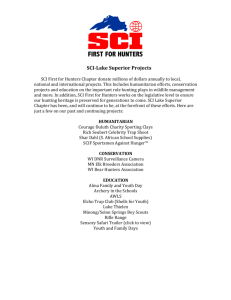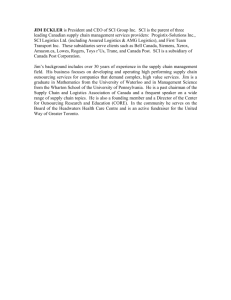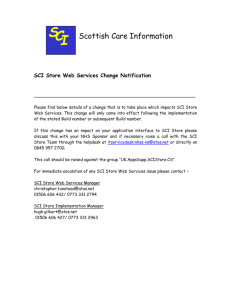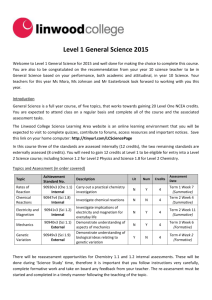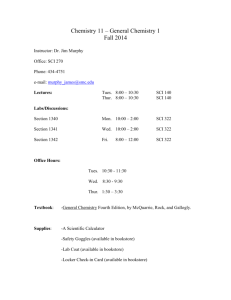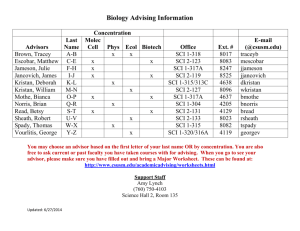course information sheet - Monroe Community College
advertisement
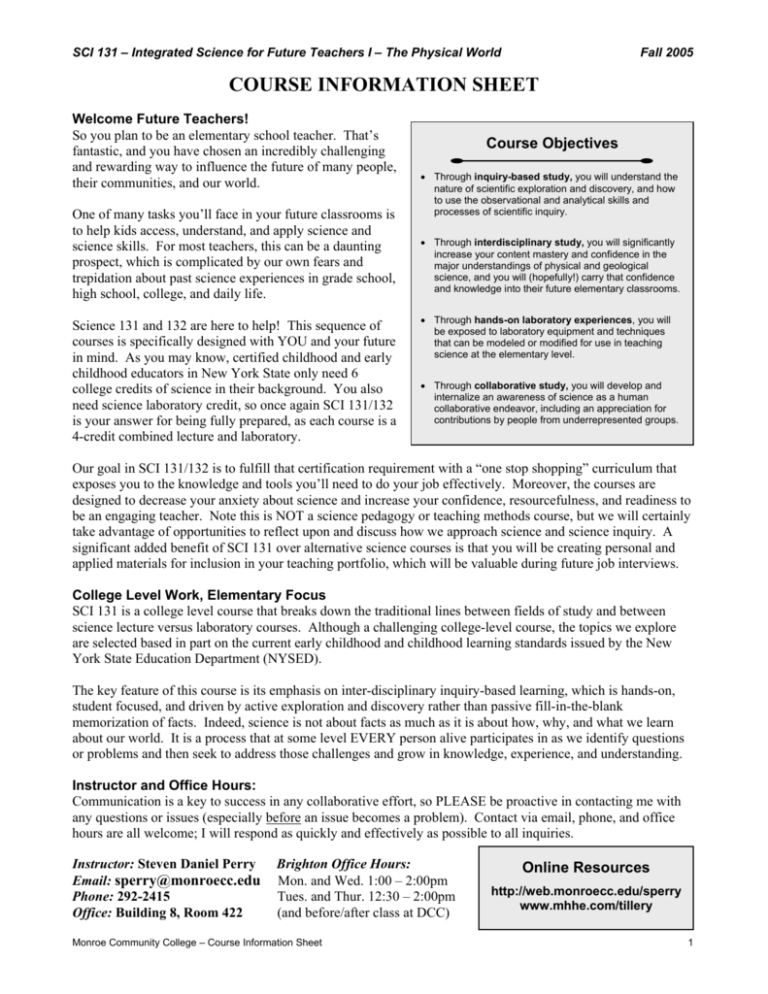
SCI 131 – Integrated Science for Future Teachers I – The Physical World Fall 2005 COURSE INFORMATION SHEET Welcome Future Teachers! So you plan to be an elementary school teacher. That’s fantastic, and you have chosen an incredibly challenging and rewarding way to influence the future of many people, their communities, and our world. One of many tasks you’ll face in your future classrooms is to help kids access, understand, and apply science and science skills. For most teachers, this can be a daunting prospect, which is complicated by our own fears and trepidation about past science experiences in grade school, high school, college, and daily life. Science 131 and 132 are here to help! This sequence of courses is specifically designed with YOU and your future in mind. As you may know, certified childhood and early childhood educators in New York State only need 6 college credits of science in their background. You also need science laboratory credit, so once again SCI 131/132 is your answer for being fully prepared, as each course is a 4-credit combined lecture and laboratory. Course Objectives • Through inquiry-based study, you will understand the nature of scientific exploration and discovery, and how to use the observational and analytical skills and processes of scientific inquiry. • Through interdisciplinary study, you will significantly increase your content mastery and confidence in the major understandings of physical and geological science, and you will (hopefully!) carry that confidence and knowledge into their future elementary classrooms. • Through hands-on laboratory experiences, you will be exposed to laboratory equipment and techniques that can be modeled or modified for use in teaching science at the elementary level. • Through collaborative study, you will develop and internalize an awareness of science as a human collaborative endeavor, including an appreciation for contributions by people from underrepresented groups. Our goal in SCI 131/132 is to fulfill that certification requirement with a “one stop shopping” curriculum that exposes you to the knowledge and tools you’ll need to do your job effectively. Moreover, the courses are designed to decrease your anxiety about science and increase your confidence, resourcefulness, and readiness to be an engaging teacher. Note this is NOT a science pedagogy or teaching methods course, but we will certainly take advantage of opportunities to reflect upon and discuss how we approach science and science inquiry. A significant added benefit of SCI 131 over alternative science courses is that you will be creating personal and applied materials for inclusion in your teaching portfolio, which will be valuable during future job interviews. College Level Work, Elementary Focus SCI 131 is a college level course that breaks down the traditional lines between fields of study and between science lecture versus laboratory courses. Although a challenging college-level course, the topics we explore are selected based in part on the current early childhood and childhood learning standards issued by the New York State Education Department (NYSED). The key feature of this course is its emphasis on inter-disciplinary inquiry-based learning, which is hands-on, student focused, and driven by active exploration and discovery rather than passive fill-in-the-blank memorization of facts. Indeed, science is not about facts as much as it is about how, why, and what we learn about our world. It is a process that at some level EVERY person alive participates in as we identify questions or problems and then seek to address those challenges and grow in knowledge, experience, and understanding. Instructor and Office Hours: Communication is a key to success in any collaborative effort, so PLEASE be proactive in contacting me with any questions or issues (especially before an issue becomes a problem). Contact via email, phone, and office hours are all welcome; I will respond as quickly and effectively as possible to all inquiries. Instructor: Steven Daniel Perry Email: sperry@monroecc.edu Phone: 292-2415 Office: Building 8, Room 422 Brighton Office Hours: Mon. and Wed. 1:00 – 2:00pm Tues. and Thur. 12:30 – 2:00pm (and before/after class at DCC) Monroe Community College – Course Information Sheet Online Resources http://web.monroecc.edu/sperry www.mhhe.com/tillery 1 SCI 131 – Integrated Science for Future Teachers I – The Physical World Fall 2005 Course Description: SCI 131 is the first in a sequence of two courses designed to explore the basics of physical science, geological science, chemistry, and biological science in an inter-disciplinary, inquiry-based approach for students wishing to pursue a career in childhood education. SCI 131 – Integrated Science for Future Teachers I – The Physical World, focuses on Earth’s physical and geologic processes and how they govern and shape the dynamic world around us. Characteristics of energy, matter, chemical interactions, and electromagnetism are explored, along with the realms of weather, water resources, rocks/minerals, landscape development, and planetary change. Prerequisites/Corequisites: No previous science, math or education course experience is necessary for success in this course. Therefore, the only true prerequisite is a positive open attitude that embraces exploration, discovery, and participatory study. SCI 131 combines lecture and laboratory components, so it is selfcontained in that way. Required Materials • • • • • • Integrated Science textbook Notebook for notes & journal Binder or folder for portfolio Colored pencils or markers Zip disk or USB jump drive DAILY POSITIVE ATTITUDE!! Required Text: Integrated Science by Tillery, Enger, and Ross (2nd ed, 2004) is available at the Damon City Campus bookstore or other source of your choice. The text has many helpful features, including accessible language, good graphics, extensive glossary, and highlight boxes focused on applying concepts and making cross-disciplinary connections. We will also be using on-line support resources at www.mhhe.com/tillery; please take advantage of these resources! Fortunately for your pocketbook, the same text is used for both SCI 131 and 132. Learning Outcomes: The following are specific learning outcomes that you can expect to achieve through successful participation in the course. Note the VERBS in these statements, and note that “successful participation” means that these are reasonable and assessable (i.e., testable) outcomes for students who fully engage in class and out, give their best as an investment in their future job performance, and take our work (and educational play) together seriously. As primary learning outcomes from full engagement in SCI 131, you will be able to: • Define the scientific method and apply the scientific method to investigate physical, chemical, biological, and geological science problems in the laboratory. • Demonstrate proper laboratory techniques used in scientific inquiry and investigations. • Recognize and describe examples of significant contributions made to science by typically under-represented members of society. • Discuss the physical and chemical characteristics of matter and energy, including the concept that matter is made up of particles whose properties determine its macroscopic characteristics and its reactivity. • Identify the major forms of energy and discuss how energy is conserved when its form changes, and how moving electric charges are the source of electric forces, magnetic forces, and light. • Summarize the physical structure and composition of Earth's lithosphere and subsurface, discuss and illustrate the dynamics associated with earthquakes and volcanoes, and apply knowledge of rocks in interpreting Earth history and geologic processes. • Access, interpret, and synthesize weather and hydrologic data to formulate conclusions about how heat, wind, water, storms, and humans modify Earth's environment and provide a basis for life. • Investigate planetary science and remote sensing technology (including missions beyond Earth), and be able to construct generalized models of time and cosmology, and compare the Earth system to examples from other planetary bodies. Monroe Community College – Course Information Sheet 2 SCI 131 – Integrated Science for Future Teachers I – The Physical World Fall 2005 Welcome to Our Community of Learners! Ideally, how we apply our time and talents in our classroom here in SCI 131 will be an effective model for the learning environment and classroom management you establish in your future classrooms. To accomplish this goal, we must be a committed community of learners, working and learning together to find those magical synergies that create a whole experience much greater than the sum of the individual parts. Science is a collaborative human endeavor, and we will embrace this idea as our daily practice by, for example: • Accepting that our classroom is a dynamic, working laboratory where any relevant ideas are openly explored. • Recognizing the value of questions as much as answers, the value of fruitful mistakes as much as success. • Celebrating diversity where everyone’s unique experience, words, and actions are respected and respectful. • Maintaining personal accountability in all work products and in support of group responsibilities. • Honestly assessing our own performance, and constructively assisting and assessing our peers. Course Content and Schedule: The following table provides an estimated schedule of course topics and target timeline (dates and topics are estimated and you will be informed if they change). Assignments and projects must be completed on or before the date/day listed. The activities of a typical week will be as follows (subject to change as needed): Monday: Start new major topic (this may not always occur on a Monday, but it is our target each week) Wednesday: Hand in completed study guide for current topic/chapter Friday: Receive new study guide for next topic/chapter; hand in major project work, as scheduled Week of: Target Topic Chap Study Guide Bulletin Board Mini Bios Exams & Other Sept 5 Welcome to Our Physical World: The Big Picture --- Sept 12 Science: Inquiry, Exploration and Discovery 1 SG 1 Sept 19 Conservation Conversations about Energy & Motion 2, 3 SG 2 Sept 26 Energy Smorgasbord: Energy Forms/Transforms 3, 4 SG 3 Oct 3 Matter in Motion: It’s an Electromagnetic World! 6 SG 4 Oct 10 Matter Matters: Nature’s Basic Building Blocks 8 SG 5 Oct 17 Matter Batter: Exploring Molecular Transformations 9 SG 6 Oct 24 The Big Blue Marble: Water on Earth 17 SG 7 Oct 31 The Atmosphere: We’re Swimming in Air 16 SG 8 Nov 7 Storm Warning! The Dynamics of Weather 16 Nov 14 Earth Science Rock-n-Roll: Greatest Hits Vol. I 14 Nov 21 Earth Science Rock-n-Roll: Greatest Hits Vol. II 15 Nov 28 Gorgeous Geomorphology: The Many Faces of Earth 15 Dec 5 Planetary Science: Space and Place for the Human Race 13 Dec 12 Synthesis Projects and Transition to SCI 132 --- Present Synthesis Dec 19 No classes; final exam time and location TBA --- Final Exam Note the following additional important dates: September 26, Monday: Last day to drop the course October 26, Wednesday: Midterm Exam November 23, Wednesday: Last day to withdraw November 24-25, Thur-Fri: No classes December 16, Friday: Last day of classes December 19, week of: Final exam time/date TBA Monroe Community College – Course Information Sheet SG 9 BB 1 BIO 1 BB 2 Journal BIO 2 BB 3 BIO 3 Midterm Exam BIO 4 Journal BB 4 BB 5 Synthesis Draft BIO 5 SG 10 BB 6 BIO 6 Journal Extra Help Is Available… If you fall behind, get confused, must miss a class, or just need to get a grip, PLEASE take advantage of “FREE” help during my office hours, or seek other assistance from the on-campus Learning Centers. 3 SCI 131 – Integrated Science for Future Teachers I – The Physical World Fall 2005 Grading Summary: Full attendance and active participation are expected, and necessary, for success in the course. Your final grade will be determined based on the following point system: Requirement Points Value Inquiry Activities 350 points 35% (primarily in-class and daily hands-on activities) Study Guides 200 points 20% (homework content review based on readings) Journal 100 points 10% (in-class and at home time for personal reflection) Midterm Exam 100 points 10% (includes content and lab practicum components) Final Exam 100 points 10% (includes content and lab practicum components) Synthesis Project 50 points 5% (culminating inquiry activity; group work) Mini Biography 50 points 5% (scientists are people too!; group work) Bulletin Board 50 points 5% (dress up our room for points!; group work) TOTAL 1,000 points 100% Using your combined total point score, a letter grade will be assigned for the course based on the following: Total Points Percent Basis Grade 930 – 1,000 93 – 100 A 900 – 929 90 – 92.9 A– For maximum credit, it is very important that you communicate 870 – 899 87 – 89.9 B+ any problems or delays in 830 – 869 83 – 86.9 B completing assigned work. 800 – 829 80 – 82.9 B– Opportunities for make-up 770 – 799 77 – 79.9 C+ exams and acceptance of late 730 – 769 73 – 76.9 C assignments is at the sole discretion of the instructor, as 700 – 729 70 – 72.9 C– allowed by College policy and 670 – 699 67 – 69.9 D+ subject to receipt of your prior 630 – 669 63 – 66.9 D written (or phone) notice/excuse 600 – 629 60 – 62.9 D– for each occurrence. 0 – 599 0 – 59.9 F Scope of Primary Work Products and Assessments As you can see in the above overview of grading, there is a wide variety of activities we will engage in to form the basis of your course grade. We will generate a variety of specific work products, which will be reviewed and graded by the instructor and/or your peers. Some of these work products require individual effort, and others require group effort. There will be ample time provided within classroom periods for you to begin or complete work individually and in groups. Other tasks will be best accomplished outside of class as homework. The following pages outline the scope, timing, and grading criteria of work products and activities for the course. Please review them carefully and ask questions early and often if clarification is needed. Other handouts and details may also be given, but the primary requirements are provided here as “official” policy. The chart below summarizes how different work products will typically be accomplished (subject to change): Individual Work Variable Team Work “A Team” Work Inquiry activities Inquiry activities Synthesis project Study guide worksheets Other in-class activities Mini biography Journal reflections Bulletin board Exams Other in-class activities Class notes Monroe Community College – Course Information Sheet 4 SCI 131 – Integrated Science for Future Teachers I – The Physical World Fall 2005 Study Guides: A total of 10 take-home study guides must be completed throughout the Build Your Portfolio! term, approximately one each week or so to correspond with major topics One major tangible outcome of and reading assignments from the course text. These study guides have your success in this course will be a myriad of materials suitable for three purposes and will be very useful in helping you manage course developing the teaching portfolio content and achieve course objectives. First, the study guides are designed you will need for certification and to help you successfully complete the reading assignments by focusing job interviews. THINK AHEAD and your attention on the most important information from the text. Secondly, keep your best work products! once completed and graded they will become study guides for your use in preparing for exams (format will mirror much of exam format). Third, the study guides will form the basis for approximately 20% of your grade; each is worth 20 points. Study guides will typically be handed out on Fridays and due on the following Wednesday, corresponding to the topic at hand that week. Study guides handed in late will be penalized a minimum of five points, and will not be accepted at all if received more than one class period late (i.e., due on a Wednesday, so not accepted at all past that Friday). This policy is an incentive for your own success by keeping you current with the material and our activities. Exams: A total of two exams will be given during the course. The midterm and final exams are each worth 10% of your course grade. The exams will include assessment of primary course content from the textbook, mini-lecture notes, lab/inquiry activities (including content AND procedures), and other assignments completed in the approximately seven weeks prior to the exam. The final exam is not comprehensive. The midterm and final exams can not be made up, so please be sure to plan well in advance to assure attendance for the exams. The midterm is scheduled for Wednesday, October 26, and the final exam will be during finals week, with the specific date, time, and location to be announced as soon as possible. Inquiry Activities: This entire course embraces inquiry as the primary and most effective approach to learning. In SCI 131 we are merging and essentially doing away with the traditional lecture and laboratory format of many other college courses. The bulk of our time in the classroom will be engaged in hands-on activities that challenge us to live the dynamic and often unpredictable process of science, not just talk about it and not just read about it. As a community of learners we are here to learn, not to “be taught”. As a community of future teachers, we are here to learn how to empower ourselves and our future students to think critically, formulate testable or resolvable questions, and to take the actions necessary to answer our questions and solve problems about the natural world. Each class period will feature hands-on activities and discussions to help us explore key concepts; create or critique models; predict, observe and measure phenomena; and understand (know and apply) major scientific processes, theories and laws. These primarily in-class inquiry activities are worth 35% of the course grade, and they will also contribute to material included in the exams (exams assess content mastery and lab procedures). Refer to the section of this syllabus regarding attendance for the policy regarding missed classes. That is, any in-class activities missed due to absence are still your responsibility (and may be difficult to reproduce/recreate). Personal Journal: Again, this course is focused on content mastery at the college level, not elementary science pedagogy. However, we still want to take full advantage of opportunities to reflect on our teaching and learning processes, as well as reflect on those “Aha!!!” moments of discovery as we practice science and learn new things. To do this you will keep a personal journal that will be reviewed three times during the semester. Because record keeping and reflection are so important to scientists, the effort is worth 10% of the course grade. Journal due dates are Fridays, October 7, November 11, and December 9, 2005. Guidelines about good journal entries will be provided and discussed, and time will be given during most class periods for reflection on the day’s activities and outcomes (there also will be some entries assigned as homework). Guiding questions and discussion will be provided to prompt your thinking about what to write about. Most entries are expected to be brief, meaning a short paragraph or up to a page or so. Sketches and creativity are also encouraged. Monroe Community College – Course Information Sheet 5 SCI 131 – Integrated Science for Future Teachers I – The Physical World Fall 2005 The following activities (mini biography, bulletin board, and synthesis project) are to be completed within your “A Team” (major permanent team of four) that you will work with throughout the semester. You will also do many things individually and in other groupings, but the following are done by your primary group. All group assignments will be assessed via a grading rubric and peer assessment. Mini Biography: One important thematic thread running through SCI 131/132 is that science is a collaborative human endeavor. To explore this idea, SCI 131 features an activity we’ll call “Scientists Are People Too!” Working in your “A Teams” you will investigate and write about a scientist, preferably from an underrepresented group such as women and/or minority scientists. You will share your findings in class. Additional details of the project will be provided separately, but for now review these requirements: • Selection of living, active scientists is strongly encouraged. Interview them if at all possible (voice, email). • Write a five-page essay about the scientist, including one page of graphics (photos, data, charts, etc.). • List of references cited (you must have at least four) must be included as page 6. Use proper in-text citations. • Sources must include at least one peer-reviewed scholarly journal (ask me if you do not know what this is). • Quality Internet sources may be used. Essay WILL BE checked for plagiarism. ATTACH copies of sources. • Prepare a 12-minute presentation (plus 8-min Q&A) to share in class. All group members must participate. • Sign up for a field of study and due date will be provided. Candidate must be cleared by me before starting. Battle of the Bulletin Boards: Think back to when you were in elementary or middle school. Do you recall the many colorful posters and bulletin boards that inspired or instructed? One of the many skills you need as an elementary teacher is creation of fun and informative bulletin boards. Here’s your chance to get started!! For 5% of your course grade, each “A Team” will design and construct a science-themed bulletin board targeting a specific K-6 grade level. Each team also will write a two-page, double-spaced essay summarizing the bulletin board and related details. Criteria for Bulletin Board Criteria for Summary Essay • Minimum size = 1m x 1m; max = 1m tall x 2m wide • Two pages, double spaced, 1” margins • Must target a specific grade level (K – 6) • Outline format is encouraged and must include: o Informative, attention-grabbing title o Target grade level (discuss rationale) o Summarize key content/message at college level o Summarize key content/message at grade level o Summarize expected learning outcomes (K-6) o Reference list of sources used • Theme and content must be directly related to course content (topics, phenomena, people, &/or processes) • Hung in classroom every other Friday (begin on 9/23) • Draft plan & materials list due Friday prior to install • Must demonstrate low-cost/no-cost resourcefulness A signup sheet will be provided to select your preferred date to hang the bulletin board for a two-week display. As a teacher you will need to be clever and resourceful to accomplish your goals. Therefore, there is a maximum optional budget of $20 to cover all materials. Sorry, but it’s YOUR money, so preferably you will rely entirely on reuse, recycling, and borrowing of existing materials. Mount your masterpiece on a backing board of some kind, such as a piece of cardboard from a large appliance box. Grades will be assigned based on quality of content, creativity, resourcefulness, grade-level awareness, quality of essay, and peer assessment. Synthesis Project: To culminate our learning together, your “A Team” will prepare and present a synthesis project during the week of December 12, 2005. The purpose of the project is to prepare a lesson plan for your peers (and your teaching portfolio!) to demonstrate inquiry-based teaching of a K-6 grade-appropriate science concept, phenomenon, or process of your choice. Length and detail are up to you. Content must be tied to SCI 131, plus the following: • Written rough draft is due November 18, 2005. I will review, comment, and return to you within a week. • Lesson will be taught to/with your peers during the week of December 12, 2005. Plan on approx 30 minutes. Monroe Community College – Course Information Sheet 6 SCI 131 – Integrated Science for Future Teachers I – The Physical World Fall 2005 • Components of the lesson plan must include (additional details about the project will be provided later): o Learning objective(s): clear, assessable (measurable, testable), tied to grade level and NYS Standards. o Classroom management: materials and time needed, procedure for managing students and process. o Inquiry: who, what, why, and how are the lesson, activities, concepts, outcomes inquiry based? o Teaching notes, grade level: outline the content of the lesson at the grade level to be taught. o Teaching notes, college level: outline the content of the lesson at a college-level of understanding. o Activities: provide brief description of hands-on activities and provide handouts or worksheets. o References: provide a properly-formatted list of resources used to create the lesson plan. Attendance, Special Needs, and Academic Honesty: Full attendance and participation are necessary for success. Thus, the College’s attendance policy will be enforced. As stated in the MCC catalog and student handbook, “Prompt and regular attendance at all class sessions is expected. Faculty members are asked to report students for excessive absence when such absence is adversely affecting the student’s academic achievement (not necessarily failing work)…” Three absences will result in mailing of an attendance warning letter, and four absences will result in the student being involuntarily withdrawn from the course. Poor attendance and faculty-initiated withdrawal may adversely impact your financial aid and academic standing. Attendance will be taken at the start of each class session, so arriving significantly late may be deemed an “absence.” If you must unavoidably miss a class, you are still fully responsible for the work and activities missed. Out of respect for the instructor and those students who were in a class period you missed, you will NOT be given extra in-class time to catch up, and you are NOT to encumber or diminish the work efforts of your group members. Any student with a special need (or known medical condition that may require emergency response) must promptly inform Student Services and the instructor so that appropriate accommodation can be arranged. The College’s academic honesty policy will be strictly enforced: “In the academic process, it is assumed that intellectual honesty and integrity are basic responsibilities of any student” (MCC Catalog and Student Handbook). Cheating or any form of plagiarism will not be tolerated, will be reported to Student Services for investigation, and will result in a zero (failing) grade for the assignment/exam involved (including all members of a group if it is a collaborative assignment; no exceptions, no questions, no whining!!) Learning Center and Tutoring Resources: To provide extra help with your coursework, the Brighton Campus has several Learning Centers (e.g., Natural Science, Accounting, Math, Nursing, Psychology, Writing, and the Electronic Learning Center), and the Damon City Campus features the Integrated Learning Center. For example: Electronic Learning Center: Brighton Building 11, Room 106 (call ext. 5267) Natural Science Learning Center: Brighton Building 9, Room 129 (call ext. 2596) Integrated Learning Center: Damon 4130 and Electronic Learning Center: 4071 A brochure with additional details on Learning Centers is available. Learning Centers offer well-qualified instructional staff and may be equipped with computers and other resources. It is strongly recommended that you use these Learning Centers to get assistance with concepts learned in the classroom, and for other needs regarding tutoring and completion of assignments and projects. Class Cancellation and Emergency Closings: Information on class cancellations is available daily on the web or through the telephone. Simply go to the MCC website (www.monroecc.edu), locate the “Quick Links” window on the homepage, and click on “Class Cancellations.” Additionally, class cancellation information is available by dialing 292-2066, press “1” for the Brighton Campus or “2” for the Damon Campus. If possible, please use the web as there could be delays in the voice recordings based on the number of cancellations. If the college is closed due to inclement weather or some other emergency, all Rochester area radio and television stations will be notified no later than 5:30 a.m. In addition, the homepage on the MCC website (www.monroecc.edu) will display a message indicating the College is closed. Please do not call the College to avoid overloading the telephone lines. Monroe Community College – Course Information Sheet 7

